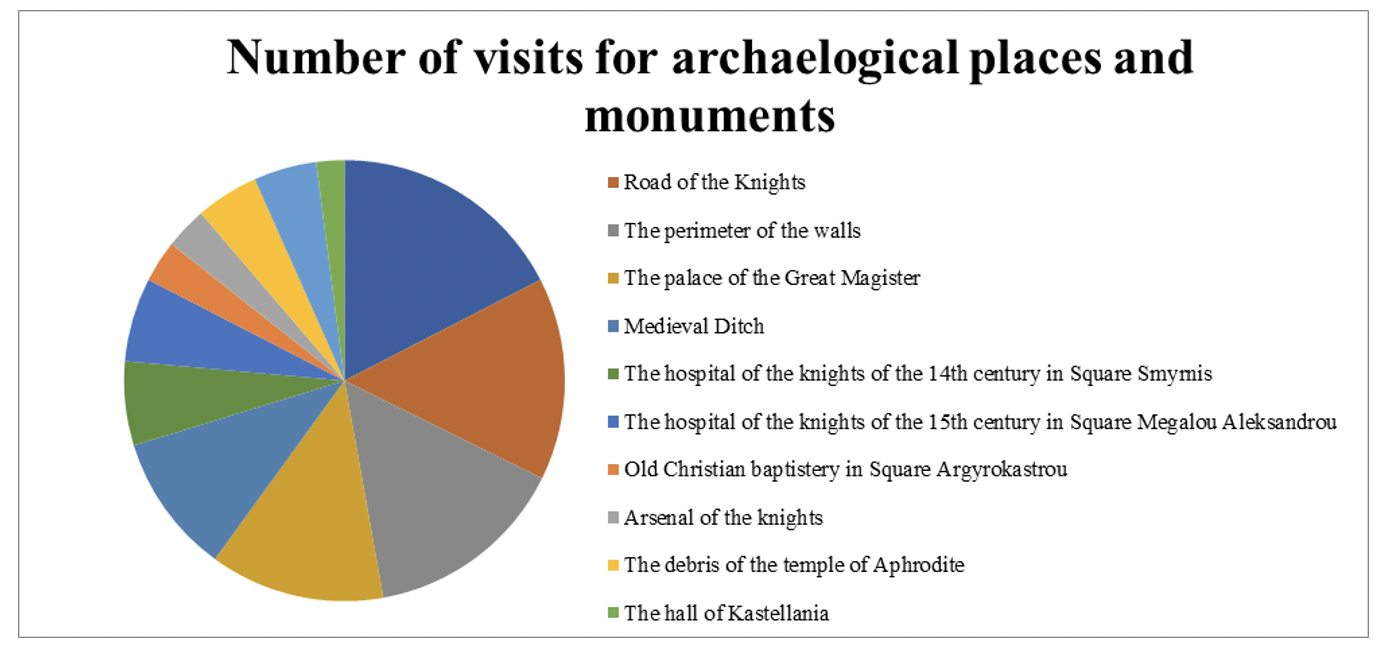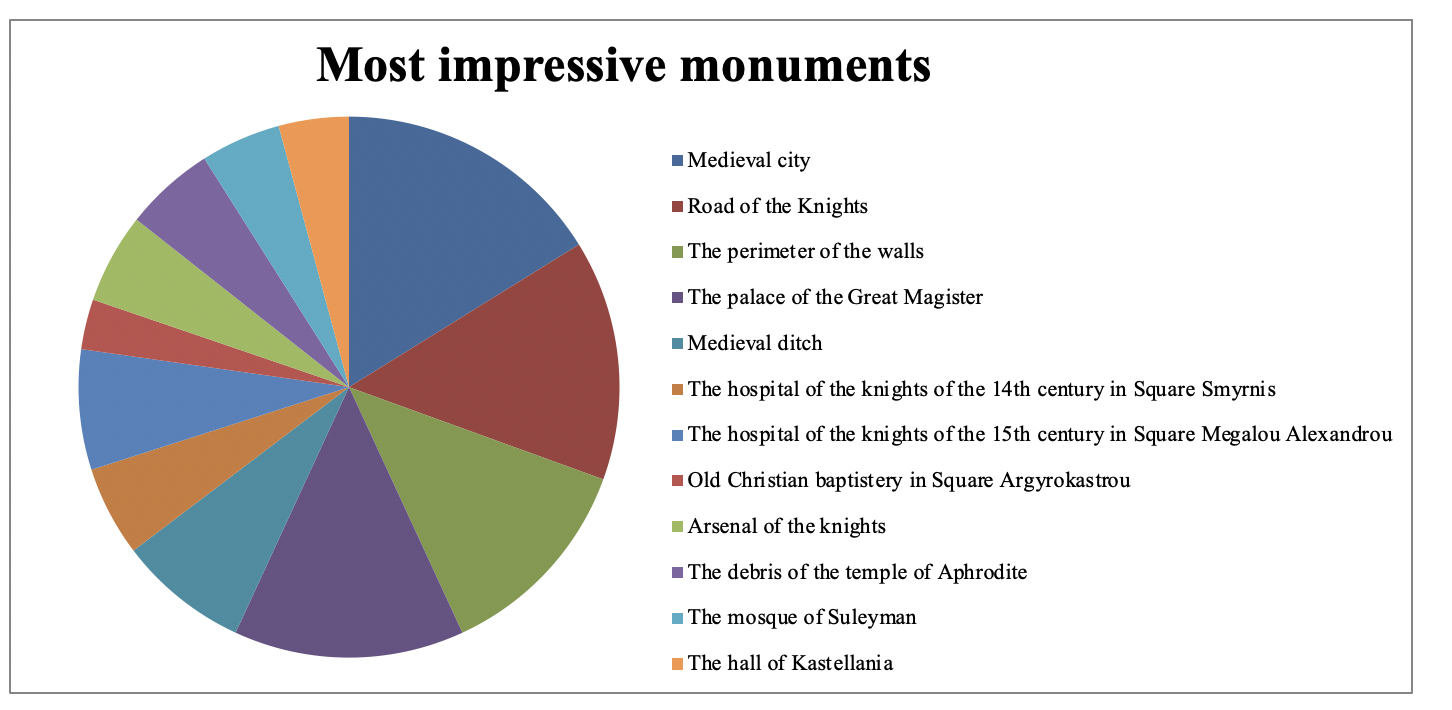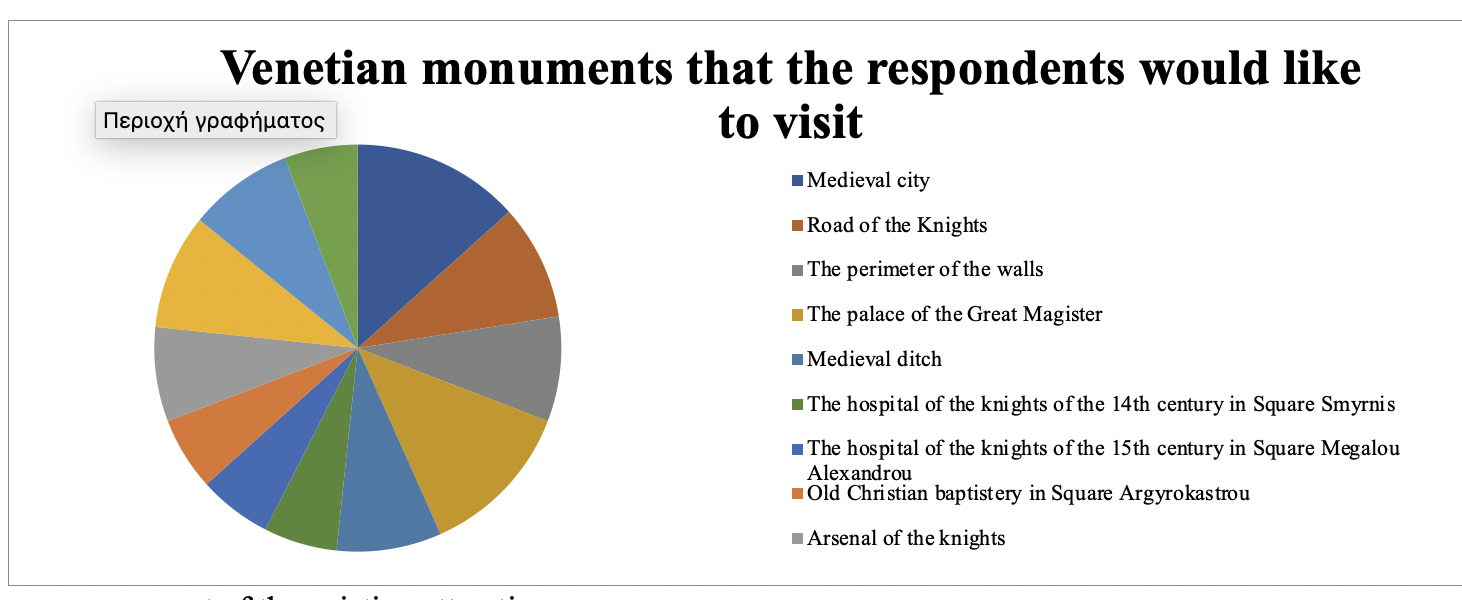KOLTSIKOGLOU GEORGIOS
Master of International Law (L.L.M) from the University of Teramo, Italy
FOTEINH MANIOU
Graduate of Philosophy NKUA, Msc University of the Aegean
TAXIARCHIS VOUGLANIS
PhD Sociology, Aegean University
KLEOPATRA MANTZOURANI
Graduate of Educational Department of Kindergarten - NKUA, Msc Theory Practice and Evaluation of Educational,
NKUA.
SUMMARY
Rhodes, like most of the islands, is based on its tourism sector. It has a rich cultural tradition and is full of remarkable monuments that attract the interest of visitors. The era of Italian rule left a strong imprint of Italian culture and was the starting point for the development of tourism in the area. The contribution of Italian architects and politicians was essential since many buildings of that period are still preserved today, conveying to potential visitors the history and culture of this special island. The purpose of this paper is to inform the reader about the importance of the Italian monuments in Rhodes but also to examine their current state and to investigate through quantitative research data the impact of the monuments in the present day.
Keywords: Cultural heritage, Venetians, Rhodes, cultural tourism.
INTRODUCTION
The phenomenon of cultural tourism has a particular flourishing in Greece and is a key source of income (Manola,2019)The island of Rhodes has been a crossroads of many different cultures which has contributed to the formation of a rich cultural infrastructure and historical identity. From the end of the Neolithic period to the period of the Italian occupation, each culture left its own mark. The archaeological and historical monuments, which are still preserved today, are proof of this. An important reason why Rhodes became a pole of attraction for many people was its geographical location, as it is situated between Europe, Asia and Africa. Thus, the island flourished in areas such as maritime trade, navigation, art, architecture, but also in areas such as politics and science in general. As an island, it had been subjected to various interventions by its conquerors, the most important being those of the Hippocratic, Ottoman and Italian periods (Kollias, 2007).
HISTORICAL BACKGROUND
Since the 15th of August 1309 when the Knights Hospitallers conquered Rhodes, turned into the only wall against the Ottoman empire. During its occupation by the Knights, strong walls and magnificent buildings were constructed. Rhodes became an ecclesiastical state and this gave it great value as a commercial power. As an ecclesiastical state it had many privileges, perhaps the most important of which was the possibility of minting coins. On the 25 th of May 1480 it suffered the first strong attack by Mohammed II that lasted 3 months until the retreat of the Ottomans.
The end of this period came on the 22th of December 1522 when Suleiman I the Magnificent managed to conquer Rhodes. However, Suleiman encountered difficulties during the siege and so on the 10th of December he called the Grand Master to an honorable capitulation. The most important of the terms were that the inhabitants would be exempted from taxes for 5 years and that the children of the island's inhabitants would be exempted from child molestation. Finally, on the 22th of December, the city was was handed over to the Turks with the basic terms of the treaty being the freedom of the inhabitants to follow their religious beliefs, not to plunder the Christian churches, not to tax the inhabitants for 5 years so that they can "recover" from the hardships of the war and so that as many residents as they want can leave the city of Rhodes. On the 25th of December the agas with 4000 soldiers and not the entire army as they had agreed with the Ioannites took the city from the knights and on January 1st the knights along with 4000 inhabitants withdrew the island. Despite the agreement the Turks used violence against the inhabitants of the city and proceeded to plunder. During the Ottoman occupation of the island the Rhodians suffered severe oppression by the Turks and that is why they tried 3 times to liberate themselves and with the instigation of the St John’s Knights, this had a heavy price for them as one of the prices was their persecution outside the city walls. (Kolias, 2011)
At the end of the 16th Century, because of the bloody reprisals against the Greek Christians who resisted, there gradually began to be an acceptance of the new administration. However, for trade to begin to flourish again and for there to be economic stability in Rhodes they had to wait another century, because the Ottomans had emphasized in the 16th and 17th century the development of Smyrna as a trading post. Thus the city of Rhodes, during the Turkish occupation, turned into a mere Ottoman province and was now a place of exile for those high court officials and downfallen patriarchs of Constantinople who fell into disfavour. During the first years of the occupation there were 5000 Turks and 150 Jews in the city, probably coming from Thessaloniki and Euboea (Tsirpanlis, 2002).
The castle became a place of residence of the Ottomans and this had an impact on the image of the city. Turkish officials who were also granted farmhouses on the outskirts of the city turned them into mansions with small gardens and crops. It is worth noting that even those who had some business activity within Rhode’s walls had to leave the city at sunset, when the gates were closed preventing Greeks from entering in. As far as taxation was concerned, the Rhodians after the five years grace period, were taxed like the rest of the territory with the only difference being that children were free to remain in their families.
In the beginning the economy was based on agriculture, but in the 18 th to 19 th century the port began to be considered as a trading post again and returned to its former glory. From the middle of the 19 th century, however, due to the fact that the Ottoman Empire suffered a devaluation of its currency, it was led to an increase in taxes on salt, tobacco and in general prices increase of the products. This resulted in losing the island its financial power (Papachristopoulos, 1994).
Thanks to the Anglo -Turkish Treaty they managed to recover in 1838. A huge problem was the lack of education where most people were illiterate. To have a rudimentary education one had to be middle or upper class. In the late 1900
The imprint of the Italians on the cultural heritage of Rhodes
The city of Rhodes, in 1912 when the Italians took in charge, was almost an abandoned city, with Oriental characteristics as Jews, Ottomans and a certain number of Greeks (outside the walls) where the inhabitants. Rhodes was not the original goal of the Italians, but they gradually realized its great power and thus began a new chapter in the history of the island (Louloudaki, 2020a).
The Italians fell in love with the island, especially with the old town and that's why they tried to incorporate their culture. And by that, the Old Town became a Medieval Town. Rhodes passes under the Italian occupation thanks to Mussolini, who anoints Mario Lago as governor to implement the Italian policy. One of the policies implemented was the transfer of Italian residents, who were in dire economic situation, to the island, thus creating the so-called "Italian Villages" which functioned as centers of agricultural production (Louloudaki, 2020b).
The will of Mario Lago, who had special skills in architecture, was the construction of a large University Hospital (the Old Hospital of Rhodes) that would serve patients with specific health problems from the Eastern Mediterranean. As a governor he paid particular attention to the flourishing of commerce and buildings to be constructed or repaired. This plan of action aimed so that the city meets the demands of tourism and, above all, to highlight the city as a model center of development and culture based on Italian standards. At the same time, small and isolated interventions were carried out which highlighted the island even more. Some of these were the removal of the cemeteries from the City that existed there until 1916, the extension of the road network from 29km to 69km, the restoration of the water supply system and the construction of defense mechanisms.
In general, the aim of the Italians and, by extension, of the commander, was to highlight the glory of the Knightly period and to display the architecture of the time and to eliminate Turko-Baroque elements that lacked aesthetics and decoration. Thus, many Italian architects of that period contributed to the remodeling and design of a variety of projects. (Louloudaki, 2020a)
Florestano Di Fausto was the first to be assigned with the restoration of the city during his tenure from 1924 to 1928, when he was deposed from the city's authority. He carried out many redevelopment projects in the area with the aim of making it the "New Italian City" or otherwise Medieval City, which started from the castle and went all the way to Monte Smith. Administrative buildings, residences of the high- ranking and schools were constructed throughout the city, thus concentrating all the central functions. Homes were also built at this time, with low rents, for the economically weak Italian citizens. Other projects carried out by Di Fausto are the Historical-Archaeological Institute under the name "Fortune helped me keeping Rhodes", which dealt with issues of history and law, the Government Hall of Rhodes, the Hotel of the Roses, the University of the Aegean, etc. However, most of the buildings on the island of Rhodes were undertaken by Pietro Lombardi, with his first project being done in 1928 and the most important one being the Art Gallery in Symi Square which was completely constructed in 1932. Another architect of the Italian Occupation Period was Rodolfo Petracco was Rodolfo Petracco, who built the large fountain in the Old Town (1929-1930), the current Tourist Port with the Port Authority etc. (Farmakidis, 2020).
Armando Bernabiti then built some buildings such as the National Bank in the old town, the Aquarium, the National Theatre, etc. All these projects and initiatives were not only carried out during Mario Lago's term of office but also during the tenure of De Vecchi who succeeded Mario Lago in 1936. The Italians left a great cultural heritage all over the island, but most importantly that of the Medieval Town, in which the most famous and culturally important monuments are included. These are the Grand Master's Palace, a part of which was restored in 1937, the 14th Century Hospital of the Knights in Symi Square, the 15th Century Hospital of the Knights in Alexander the Great Square, which today operates as the National Archaeological Museum, the Knights' Street, the Municipal Gallery in Symi Square, the early Christian Baptistry which was moved to Argyrokastro Square and transformed into a fountain, the Knights' Armoury which today houses the Folklore Museum or Museum of Folk Art, the ruins of the Temple of Aphrodite, the Suleiman's Mosque, the Mansion of Castellania which today houses the Municipal Library, the Virgin Mary of the Castle, the Medieval moat and the perimeter of the Walls. Therefore, it is no coincidence that the Medieval City is classified by UNESCO as a World Heritage Site, as the entire history is written on it since antiquity (Directorate of Information Technology of the Municipality of Rhodes, 2016a, 2016b).
Their contribution to the touristic evolution of the place
As the penultimate conquerors, the Italians held in their hands the cultural heritage of Rhodes, or in other words its continuity. Through their actions, it is clear that all these infrastructures were also aimed at the touristic development on the island. Proof of this tourism policy is the construction of hotels, the most representative of which are the 'Thermae' in the city of Rhodes and the 'Elaphos'. In addition, the Kallithea thermal springs, the beaches, the partial elements of the Italian effort to develop the touristic Golf Course is apparent in the island. (OT.gr Newsroom, 2022) Another parameter that played an important role in developing tourism was due to the fact that Rhodes ceased to be a commercial port due to the loss of trade with Asia Minor, Africa and the Middle East and thus the Italians decided to turn Rhodes into a touristic attraction. (Louloudaki,2020c)
The visitor has the opportunity to follow remarkable walks such as that of the Medieval Trench as well as that of the Perimeter of the Walls. The Virgin Mary of the Castle of the 11th Century A.D. is also considered a remarkable monument which is the largest and oldest surviving church in the Medieval City. In addition to the historical interest, it causes to the visitor, the Medieval City hosts all kinds of shops, restaurants, taverns, accommodation, night entertainment centers and is one of the hottest spots points of the island. In the City, in the Theater of the Trench, in the Grand Master’s Palace and in various other venues of Venetian monuments, among others, international cultural events, ancient drama performances, music concerts, the international ecological film festival Ecofilms and the wine festivals in the village of Empona are organized. Also the factor of empathy is a key element in tourism (Manola & Papagrigoriou,2020).
QUANTITATIVE RESEARCH ON THE CURRENT IMPACT OF THE VENETIAN MONUMENTS.
A questionnaire was conducted in Athens in October 2022 which received a total of 358 responses. Participants were of all genders and ages, with all types of education. Even if the respondents are not from Attica, the vast majority of them resides permanently in the city of Athens and has not visited the island of Rhodes (62.1%). Nevertheless, most of them know about its rich history, and have been informed about the Venetian monuments that are mainly housed in the Old Town.
Figure 1. "Have you visited archaeological sites and monuments?"

The above-mentioned monuments stand out, with the Medieval Town (94.4%), the Knights' Street and the perimeter of the walls (80.6%) and the Palace of the Grand Master (69.9%) being the first preference of visitors. The majority of respondents consider most of these monuments to be in a very well-preserved condition, with the best preserved being the famous Knights' Street (72.8%) and the Castle Church of Our Lady of the Castle (29.4%) being less well preserved.
However, it seems that a large number of people feel that most of them could have received better maintenance from the relevant authorities, with the highest percentage considering the perimeter of the Walls (39.9%) and immediately after, Knights Street (33.3%).
Figure 2. "Of the monuments you visited, which ones impressed you the most?"

The largest percentage of tourists who have visited the island of Rhodes (81.9%) consider that the most remarkable Venetian monument is the Medieval Town in the center of the island. Indeed, the rich history within the narrow streets is something that attracts the attention of many visitors and the relevant authorities have taken care to make the most of it. In second place is the Palace of the Grand Master (79.3%) and in third place, the Knights' Street (72.8%).
97.4 % of respondents believe that all these monuments contribute to the development of the local community in various ways, such as economically, by attracting tourists and by creating a good "reputation" outside the island. 92.3% would recommend someone who has not yet visited the island to visit it, as well as the Venetian archaeological sites.
The sample that has not visited the island amounts to 62.1% and covers the largest percentage of responses. However, 87% of respondents reported being informed about the island of Rhodes, mainly by a friend or acquaintance who visited the island or
from the internet. Additionally, within this percentage, only 56.6% were informed about the Venetian monuments.
The largest percentage (80%) remember the Medieval City and immediately after the perimeter of the Walls (73.3%) and in more detail show particular interest in visiting most of the existing attractions:
Figure 3. "If you ever visit the island of Rhodes, which Venetian monuments would you like to see up close?"

The majority (92.6%) would like to visit the island of Rhodes in the future and 53.8% expect to do so within the next 3-4 years. The main reasons that prevent them from visiting are either financial or work-related.
Conclusions
Today, the visitor of the Old Town sees works that are witnesses of the Venetian era in Nissos. The cultural and tourist importance of these works is expressed by the number of visitors, which this year exceeded 1.7 million visitors from all over the world. The Italians managed to turn the island of Rhodes into a tourist destination of global interest, investing in it in every sense. The city of Rhodes is one of the most beautiful cities in the world through which the traveler has the opportunity to experience unforgettable moments while enriching his knowledge. It is a destination for people of all ages, covering every kind of need in terms of interests and purpose of visit.
Bibliography
Kolias, I. (2011). The Knights of Rhodes, the Palace and the city.Ed. Ministry of Culture, Athens.
Kollias, I. (2007). 15 Years of Restoration in the Medieval Town of Rhodes: proceedings of the international symposium: Rhodes 14th -18th November 2001, Volume I, Ministry of Culture, Athens.
Louloudaki, R. (2017). The Sultan's firmania, the demogerontia, and taxes during the period of the slavery of Rhodes. November 10. Retrieved from https://www.rodiaki.gr/article/377614/ta-firmania-toy-soyltanoy-h-dhmogerontia- ki-oi-foroi-thn-periodo-ths-doyleias-ths-rodoy Information Technology Directorate of the Municipality of Rhodes (2016a). Retrieved from https://www.rhodes.gr/i-poli-mas/istorika-stichia/
Louloudaki, R. (2020a). The Italians took Rhodes "by mistake"!.24 January. Retrieved from https://www.rodiaki.gr/article/429965/oi-italoi-phran-th-rodo- kata-lathos
Louloudaki, R. (2020b) The Italian miracle with the buildings, the streets, the beauty of alien Rhodes, 29 January. Retrieved from https://www.rodiaki.gr/article/430224/to-italiko-thayma-me-ta-kthria-toys- dromoys-thn-omorfia-ths-allotinhs-rodoy
Louloudaki, R. (2020c). The Italian conquerors plundered us but invested in Rhodes. 7 February. Retrieved from https://www.rodiaki.gr/article/430826/oi- italoi-katakthtes-mas-lehlatoysan-alla-ependyan-sth-rodo
Manola, Μ. (2019). The Impact of Information Society and Cyber - Culture in Greek Tourism Phenomenon. Informatica Economică, vol. 23(1)/,p 61-71.
Manola, M. & Papagrigoriou, A. (2020). Empathy in Tourism Industry: A human-centered approach of hospitality in business world. Scientific Magazine Tourismos. V. 12(2)
Magda, M. (2008). Educational institutions of the Dodecanese, published by Ziti Rhodes.
Papachristodoulou, I. (1994) History of Rhodes, from prehistoric times to the incorporation of the Dodecanese. Second Edition.Athens, Greece.
Tsirpanlis, Z. (2002). In Rhodes of the 16th-17th century - From the Knights of Ioannina to the Ottoman Turks,ed. Ziti Rhodes.
Harami, O. (2017,) Rhodes and tourists, and knights. June 8. Retrieved from https://www.kathimerini.gr/k/travel/912667/rodos-kai-ton-toyriston-kai-ton- ippoton/
Chiotopoulou, N. (2019).Rhodes.13/5 Retrieved from https://www.ethnos.gr/travel/article/38169/rodostofroyriotonippotonkaihleykhpol h2bpics
Farmakidis, N. (2020) The Italian miracle with the buildings, the roads, the beauty of a different Rhodes, Rodiaki, 29th January. Obtained from: https://www.rodiaki.gr/article/430224/to- italiko-thayma-me-ta-kthria-toys- dromoys-thn-omorfia-ths-allotinhs-rodoy
WEBSITES
Suleiman conquers Rhodes from the Ioannite Knights who were defeated by treason and capitulated. They wandered the Mediterranean and eventually settled in Malta. Retrieved from https://www.mixanitouxronou.gr/o-souleiman- katakta-ti-rodo-apo-tous-ioannites-ippotes-pou-ittithikan-me-prodosia-ke- sinthikologisan-periplanithikan-sti-mesogio-ke-telika-egkatastathikan-sti-malta/
OT.gr Newsroom. (2022, August 27). Rhodes: Tourist arrivals on the South Aegean islands exceed 4 million. Retrieved from https://www.ot.gr/2022/08/27/tourismos/rodos-kseperasan-ta-4-ekatommyria-oi- afikseis-touriston-sta-nisia-tou-notiou-aigaiou/
Information Technology Department of the Municipality of Rhodes (2016a). Retrieved from https://www.rhodes.gr/touristikos-odigos/mnimia/
Information Technology Department of the Municipality of Rhodes (2016b). Retrieved from https://www.rhodes.gr/touristikos-odigos/mnimia/
News room. (2019, May 4). On this day in 1912 the Italians land in Rhodes.Retrieved from https://www.dimokratiki.gr/04-05-2019/san-simera-to-1912- oi-italoi-kanoyn-apovasi-sti-rodo/
